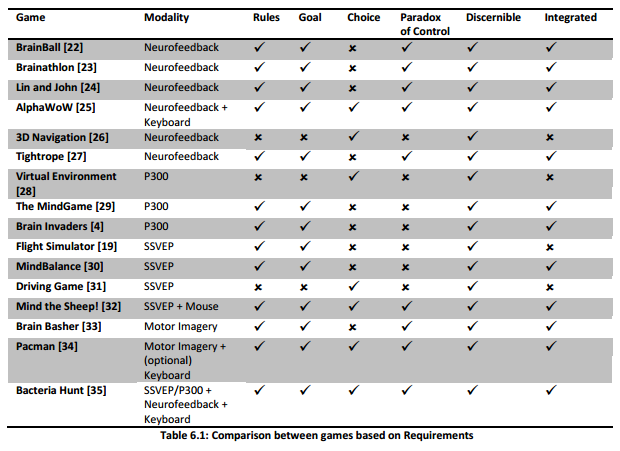
G. F. P. van Veen provides a thoughtful examination of the extent to which BCI games actually fulfill the requirements of a game in Thought Games: Advancements in Gaming with a Brain-Computer Interface from a Game Design Perspective. van Veen’s paper centers on two important questions regarding BCI game design:
- What game design elements should be a primary focus in future BCI gaming research?
- What constraints in BCI paradigms need to be taken into account from a game design perspective?
To approach these questions, van Veen traces the development of theory in regards to games back to the foundational works of Huizinga and Caillois before settling on Salen and Zimmerman‘s framework for considering digital games in particular. With Salen and Zimmerman, van Veen stresses the importance of meaningful play. Incorporating elements from the concept of flow, van Veen establishes four requirements of games (rules, a goal, choice, and control) that he will use to evaluate the extent to which BCI games are truly games. Control is further divided into three aspects for evalution; paradox of control, whereby a player should feel in control while still being open to the possibility of failure that the player must feel will only be the fault of their own; controls should be discernible to the player, so that they understand the impact of performing an action; and integrated, so that the impact of performing an action with that control yields a consequence in terms of the goals of the game. From these criteria, van Veen evaluates a variety of BCI games, including games using neurofeedback, (visual) stimulus response, and motor imagery controls (see table).
After this evaluation, van Veen groups games within their various BCI control mechanisms, and evaluates the efficacy of the mechanisms themselves for their ability to provide true gameplay. For example, while stimulus response could be viewed as a favorable control paradigm due to its relatively high accuracy and low illiteracy, such games may be too easy because of this, without providing much real choice or challenge in game play. Overall, van Veen’s review and discussion of BCI games in terms of the theory of game design provides valuable considerations for the future of neurogaming development.
Reference: van Veen, G. F. P. Thought games: advancements in gaming with a brain-computer interface from a game design perspective. Internet: http://hmi. ewi. utwente. nl/verslagen/capita-selecta/RT-Veen-Gijsvan.pdf [Aug. 31, 2013].